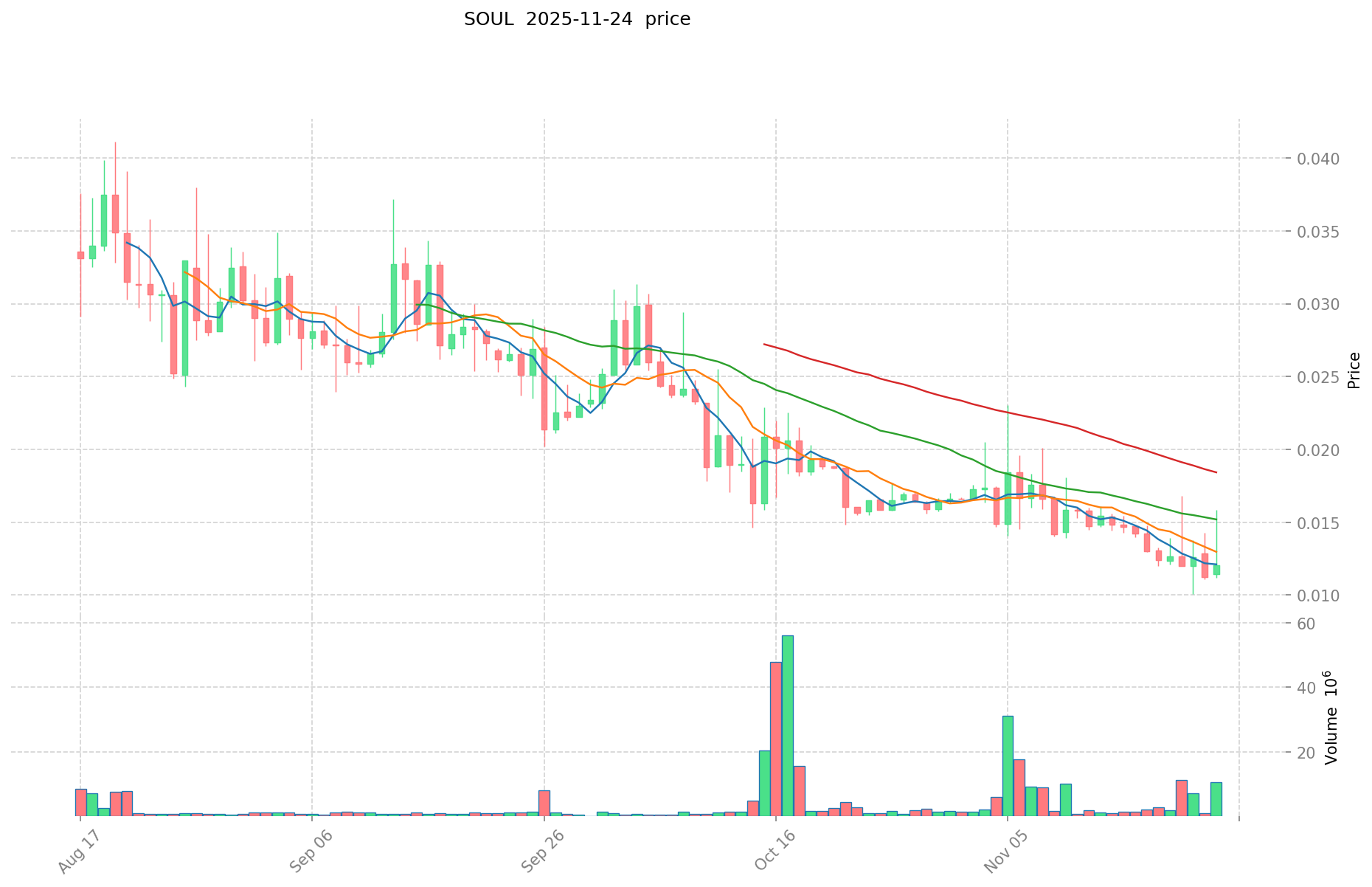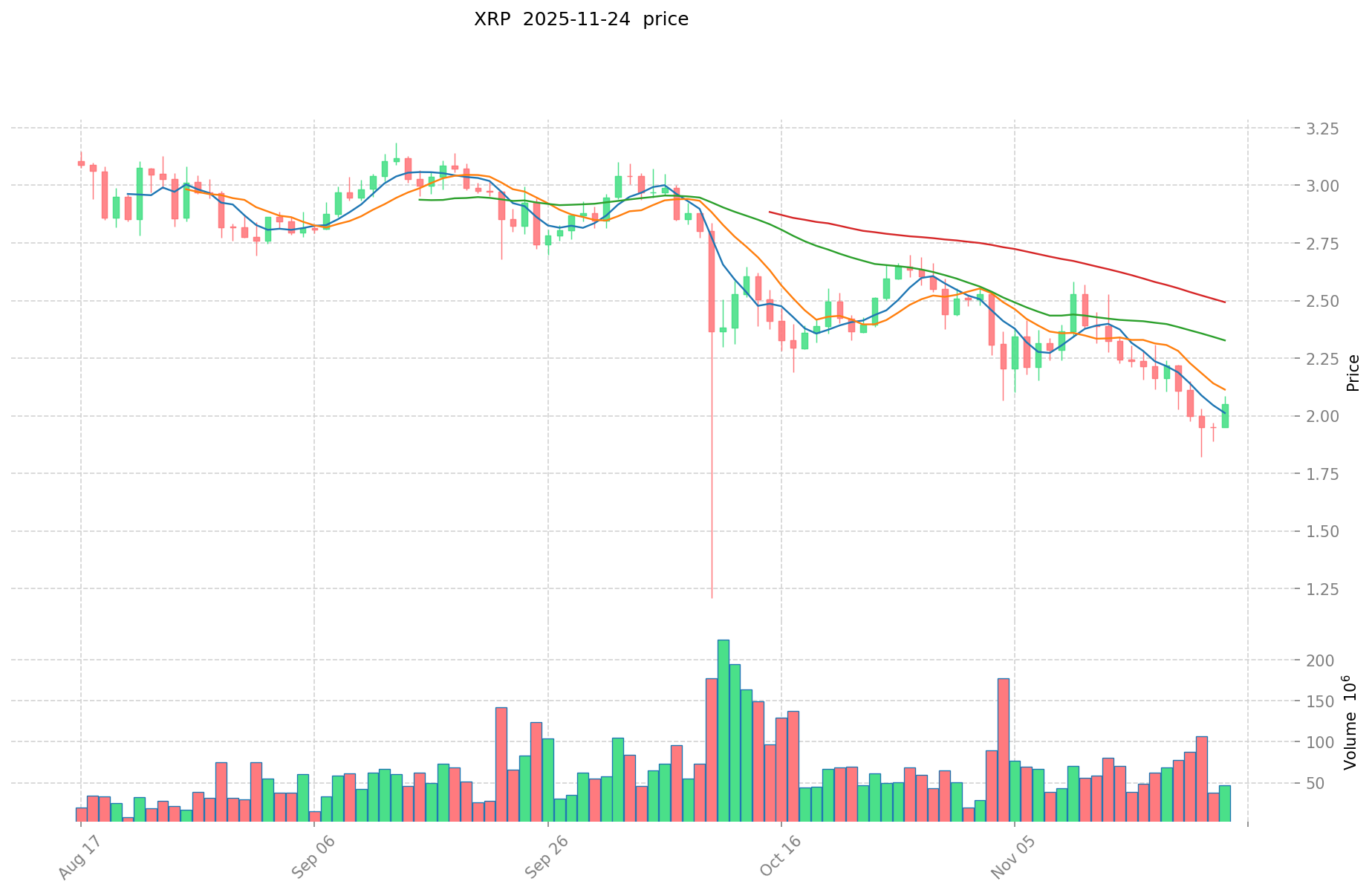SOUL vs XRP: The Battle of Emerging Cryptocurrencies in the Digital Asset Space
Introduction: Investment Comparison of SOUL vs XRP
In the cryptocurrency market, the comparison between Phantasma (SOUL) and XRP has been an unavoidable topic for investors. The two not only show significant differences in market cap ranking, application scenarios, and price performance, but also represent different positions in the crypto asset landscape.
Phantasma (SOUL): Launched in 2018, it has gained market recognition for its next-generation messaging protocol built on blockchain technology.
XRP (XRP): Since its inception in 2012, XRP has been hailed as a digital asset for fast and efficient cross-border payments, becoming one of the cryptocurrencies with the highest global trading volume and market capitalization.
This article will comprehensively analyze the investment value comparison between SOUL and XRP, focusing on historical price trends, supply mechanisms, institutional adoption, technological ecosystems, and future predictions, attempting to answer the question most concerning to investors:
"Which is the better buy right now?" Here is the report in English based on the provided template and information:
I. Price History Comparison and Current Market Status
SOUL (Coin A) and XRP (Coin B) Historical Price Trends
- 2021: SOUL reached its all-time high of $3.96 due to the overall cryptocurrency bull market.
- 2025: XRP hit a new all-time high of $3.65 in July, likely influenced by positive developments in Ripple's legal case.
- Comparative analysis: During the recent market cycle, SOUL dropped from its $3.96 high to a low of $0.0096, while XRP demonstrated more resilience, falling from $3.65 to around $2.13 currently.
Current Market Situation (2025-11-25)
- SOUL current price: $0.01286
- XRP current price: $2.133
- 24-hour trading volume: $61,429 (SOUL) vs $103,897,115 (XRP)
- Market Sentiment Index (Fear & Greed Index): 19 (Extreme Fear)
Click to view real-time prices:
- View SOUL current price Market Price
- View XRP current price Market Price


Core Factors Influencing Investment Value of SOL vs XRP
Supply Mechanism Comparison (Tokenomics)
- XRP: Fixed supply of 100 billion tokens with deflationary model through minimal transaction burn
- SOL: Inflationary model with declining emission rate, targeting long-term inflation of 1.5%
- 📌 Historical pattern: XRP's fixed supply contributes to volatility during regulatory clarity periods, while SOL's controlled inflation supports ecosystem growth.
Institutional Adoption and Market Applications
- Institutional holdings: XRP attracts traditional financial institutions seeking compliant cross-border payment solutions
- Enterprise adoption: XRP integrated with SWIFT for bank transfers; SOL favored for high-performance DeFi and NFT applications
- Regulatory attitudes: XRP benefits from regulatory clarity following legal settlement; SOL faces less direct regulatory scrutiny
Technical Development and Ecosystem Building
- XRP technical upgrades: Integration with SWIFT expected by 2025 to enhance banking applications
- SOL technical development: Focuses on scaling solutions while maintaining decentralization and security
- Ecosystem comparison: SOL leads in DeFi TVL, NFT marketplaces, and developer activity; XRP building specialized payment networks
Macroeconomic Factors and Market Cycles
- Performance in inflationary environments: XRP positions as a bridge currency for institutional transactions; SOL valued for its high-throughput technical infrastructure
- Monetary policy impact: Both assets sensitive to interest rate changes, with XRP historically more correlated to traditional markets
- Geopolitical factors: XRP benefits from increased cross-border payment demand; SOL gains from growing demand for efficient blockchain infrastructure
III. 2025-2030 Price Prediction: SOUL vs XRP
Short-term Prediction (2025)
- SOUL: Conservative $0.0073535 - $0.01337 | Optimistic $0.01337 - $0.0151081
- XRP: Conservative $1.2993 - $2.13 | Optimistic $2.13 - $2.9181
Mid-term Prediction (2027)
- SOUL may enter a growth phase, with estimated prices ranging from $0.008960634165 to $0.0199296863325
- XRP may enter a consolidation phase, with estimated prices ranging from $1.8207234675 to $3.0923398575
- Key drivers: Institutional capital inflow, ETF, ecosystem development
Long-term Prediction (2030)
- SOUL: Base scenario $0.012185687717155 - $0.022566088365102 | Optimistic scenario $0.022566088365102 - $0.031818184594795
- XRP: Base scenario $2.724912948695175 - $3.784601317632187 | Optimistic scenario $3.784601317632187 - $4.011677396690118
Disclaimer
SOUL:
| 年份 | 预测最高价 | 预测平均价格 | 预测最低价 | 涨跌幅 |
|---|---|---|---|---|
| 2025 | 0.0151081 | 0.01337 | 0.0073535 | 8 |
| 2026 | 0.0166596885 | 0.01423905 | 0.009112992 | 15 |
| 2027 | 0.0199296863325 | 0.01544936925 | 0.008960634165 | 24 |
| 2028 | 0.023527071962362 | 0.01768952779125 | 0.011675088342225 | 43 |
| 2029 | 0.024523876853399 | 0.020608299876806 | 0.01380756091746 | 66 |
| 2030 | 0.031818184594795 | 0.022566088365102 | 0.012185687717155 | 82 |
XRP:
| 年份 | 预测最高价 | 预测平均价格 | 预测最低价 | 涨跌幅 |
|---|---|---|---|---|
| 2025 | 2.9181 | 2.13 | 1.2993 | 0 |
| 2026 | 3.2560245 | 2.52405 | 2.3978475 | 19 |
| 2027 | 3.0923398575 | 2.89003725 | 1.8207234675 | 36 |
| 2028 | 4.2175758607875 | 2.99118855375 | 2.572422156225 | 41 |
| 2029 | 3.964820427995625 | 3.60438220726875 | 3.243943986541875 | 70 |
| 2030 | 4.011677396690118 | 3.784601317632187 | 2.724912948695175 | 78 |
IV. Investment Strategy Comparison: SOUL vs XRP
Long-term vs Short-term Investment Strategies
- SOUL: Suitable for investors focused on ecosystem potential and next-generation messaging protocols
- XRP: Suitable for investors interested in cross-border payment solutions and institutional adoption
Risk Management and Asset Allocation
- Conservative investors: SOUL: 10% vs XRP: 90%
- Aggressive investors: SOUL: 30% vs XRP: 70%
- Hedging tools: Stablecoin allocation, options, cross-currency portfolio
V. Potential Risk Comparison
Market Risks
- SOUL: Higher volatility, lower liquidity, and market cap
- XRP: Regulatory uncertainty, correlation with traditional markets
Technical Risks
- SOUL: Scalability, network stability
- XRP: Centralization concerns, potential security vulnerabilities
Regulatory Risks
- Global regulatory policies may have different impacts on both assets, with XRP facing more scrutiny due to its focus on traditional financial systems
VI. Conclusion: Which Is the Better Buy?
📌 Investment Value Summary:
- SOUL advantages: Next-generation messaging protocol, potential for ecosystem growth
- XRP advantages: Established cross-border payment solution, institutional adoption, regulatory clarity progress
✅ Investment Advice:
- New investors: Consider a small allocation to XRP as part of a diversified portfolio
- Experienced investors: Balanced approach with both SOUL and XRP, adjusting based on risk tolerance
- Institutional investors: Focus on XRP for its potential in cross-border payments and regulatory progress
⚠️ Risk Warning: The cryptocurrency market is highly volatile. This article does not constitute investment advice. None
VII. FAQ
Q1: What are the main differences between SOUL and XRP? A: SOUL is a next-generation messaging protocol on blockchain, while XRP focuses on cross-border payments. XRP has a larger market cap, higher liquidity, and more institutional adoption, whereas SOUL offers potential for ecosystem growth in messaging and DApps.
Q2: Which coin has shown better price performance recently? A: XRP has demonstrated more resilience in the recent market cycle. While SOUL dropped from its all-time high of $3.96 to around $0.01, XRP fell from $3.65 to about $2.13, showing better price stability.
Q3: How do the supply mechanisms of SOUL and XRP differ? A: XRP has a fixed supply of 100 billion tokens with a deflationary model through minimal transaction burn. SOUL, on the other hand, has an inflationary model with a declining emission rate, targeting long-term inflation of 1.5%.
Q4: What are the key factors influencing the investment value of SOUL and XRP? A: Key factors include supply mechanisms, institutional adoption, technical development, ecosystem building, regulatory attitudes, and macroeconomic factors such as inflation and interest rates.
Q5: How do SOUL and XRP compare in terms of institutional adoption? A: XRP attracts traditional financial institutions seeking compliant cross-border payment solutions and has been integrated with SWIFT for bank transfers. SOUL is favored for high-performance DeFi and NFT applications but has less institutional adoption compared to XRP.
Q6: What are the potential risks associated with investing in SOUL and XRP? A: SOUL faces higher volatility, lower liquidity, and potential scalability issues. XRP's main risks include regulatory uncertainty and correlation with traditional markets. Both face technical risks and are subject to overall market volatility.
Q7: Which coin might be more suitable for different types of investors? A: XRP may be more suitable for conservative investors and those interested in cross-border payment solutions and institutional adoption. SOUL might appeal to investors focused on ecosystem potential and next-generation messaging protocols. New investors might consider a small allocation to XRP, while experienced investors could balance both in their portfolios.
Share
Content